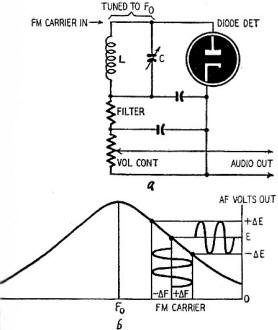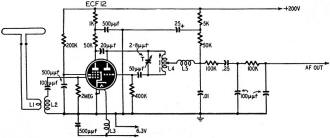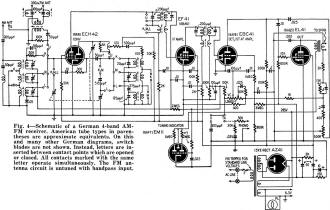FM Broadcasting in Western Germany |
|
While FM broadcasting (frequency modulation) began in the United States in the late 1930s, it was not until after World War II and even the Korean War, in the 1950s, that the major shift to FM took place. It took even longer for FM to get a foothold in Europe mainly due to the emphasis on rebuilding essential infrastructure and manufacturing destroyed by the war. As this article points out, the newer FM radio features allowed it to thwart some of the propaganda efforts of the Soviets in East Germany who would be stuck in technologies that lag two or more decades behind the free world even to this day (ain't Communism / Socialism great?). The "medium-wave band" referenced herein is AM (amplitude modulation), so replacing dominant radio broadcasting with FM systems would effectively cut off AM propaganda. FM radios were being produced so inexpensively in the U.S. that they were very affordable in Europe was well. There is no mention of whether the West German government subsidized the purchase of FM receivers by citizens, but it would not be surprising if it did so. Blanketing a nation with high-level signals brings FM benefits to 50 million. By Professor Werner M. Nestel* Broadcast-frequency assignments in Europe are based on two international agreements: 1 - The Atlantic City Agreement (1947), which assigned the frequency band 525-1605 kc for "medium-wave" broadcasting. (Europe also has a number of "long-wave" broadcast stations on various frequencies between 150 and 530 kc.) 2 - The Copenhagen Agreement (1948), which assigned specific channel frequencies to nearly 600 European stations operating within a relatively small geographic area. Western Germany, which was not presented at the Copenhagen conferee, was allotted only a few undesirable frequencies at the high-frequency end of the medium-wave band. These were all shared channels, with unreasonable power limitations, and had to compete with very powerful stations in other countries operating on the same frequencies and on adjacent channels. The fact that Western Germany, with about 50 million inhabitants and some 10 million listeners, would be open to Communist propaganda by radio as long as its own broadcasting system did not work effectively, was not taken into account at this conference. Faced with the difficult situation, Western Germany had to devise a means of serving all its listeners through a new system of program distribution, if broadcasting as one of the most effective and important modern instruments of culture and education was not to be given up entirely. In seeking a satisfactory solution, the following possibilities were considered, and each method was tested by thorough experiments: a. Carrier-current distribution of programs over telephone circuits. b. Carrier-current distribution of programs over power lines. c. A combination of methods a and b. d. Low-power common-frequency broad- casting (on various frequencies). e. Short-wave broadcasting. f. V.h.f. AM broadcasting. g. V.h.f. FM broadcasting. System g (FM) proved so superior to all the others that it was decided to make it available to the public as fast as possible. Much of the experience gained with FM broadcasting in the United States was utilized, but in many respects new techniques had to be developed. The Basic Plan Fig. 2 - (a) FM slope detector circuit. (b) Peaking the tuned circuit below the FM carrier converts carrier-frequency deviations to audio voltage variations. In general, FM receiver circuits developed in the United States have such high sensitivities that large areas can be served by low-power transmitters. The comparatively low prices of sets, tubes, and parts in the United States make it possible to manufacture and sell the elaborate multi-tube receivers needed there. In spite of these favorable factors, FM broadcasting has not developed as a serious competitor to AM in the United States. To make sure that it does so in Western Germany - and this was not merely a matter of preference, but an absolute necessity - it was decided to blanket the entire country with field strengths of more than 1 mv/m by installing an adequate number of high-power FM transmitters. To be able to provide this high field strength over the large area required and to make a complete network of transmitters as quickly as possible the following basic requirements were established: The FM transmitting antennas were to be mounted on top of existing 600-foot vertical transmitting antennas used for medium-wave broadcasting. Assuming that the radius of the area to be served is 30% greater than the optical distance to the horizon and that the signal level at the fringes of this area should be 1 mv/m measured at 30 feet above ground level in accordance with international definition, the effective radiated power (ERP) of each transmitter must be about 60 kw. Horizontal polarization is used, as in the United States. Antenna gains of 8 to 1 can be obtained easily. Line losses between transmitter and antenna can be figured at about 20% if the FM transmitters are installed in the existing buildings now used for the medium-wave transmitters, which are generally about 600 feet from the bases of the antenna towers. This calls for a 10-kw output from the FM transmitter, a power that can be provided at reasonable cost. The high field strength available with this system everywhere has two important advantages from the receiving side: Very simple and inexpensive receiving antennas - in most cases indoor types - can be used; Good quality reception is possible without the high-sensitivity FM circuits developed in the United States. To reduce receiver selectivity requirements - helping to keep receiver costs as low as possible - the minimum frequency separation between channels was set at 0.4 mc, twice the separation used in the United States. (This does not mean that each station utilizes the full 400-kc bandwidth provided by this arrangement. Deviation is limited to ±75 kc, as in the United States, and the unused separating channels may be used eventually for additional stations.) Sixty-two FM transmitters operating between 87.5 and 100 me have been installed in Western Germany in the two years since FM was introduced. The map (Fig. 1) shows how completely they cover the territory to be served. Relatively few transmitters are needed to cover the flat northern part of the country with transmitting antennas on top of existing 600-foot towers. The southern part of the country has mountains of 6,000 feet high available for the stations, but there are deep valleys as well, so that more transmitters are needed to cover a given area in the south. One of the most important facts that made this network of transmitters possible is that the "shadow" areas cast by mountains, houses, and other obstacles are only gray - never quite black. Reception is possible not only with roof antennas, but also with indoor antennas on all floors of buildings, the ground floor included. Even indoors the electrical shadows are only gray and not black, and the high field strength assures adequate receiver-input voltages for good reception. For the future it is intended to install many more transmitters in order to offer a bigger choice of programs in the FM range. One of the many interesting special problems that had to be solved for the development of the FM technique in Western Germany should be mentioned. Fig. 3 - Low-cost superregenerative FM adapter developed for the NWDR national network. The GU8 and 6X8 are approximate American equivalents of the ECF12. In many cases a single tower is used simultaneously for radiating two different medium-wave programs with up to 100 kw power each; for one or two FM programs; and will soon also be used for television with picture and sound. The same tower also carries an FM-relay receiving antenna besides power circuits for aircraft warning lights and de-icing heaters. FM Receiver Design The ability to provide listeners with adequate receivers is the real key to success or failure of FM broadcasting. Although at first the German radio industry was against FM - partly on the grounds of the high cost of adapters and complete receivers - it finally, after several heated conferences, changed its attitude. Once the industry started developing FM receivers, such simple and inexpensive solutions were found as to start a positive race on the part of the industry in their eagerness to promote FM broadcasting. The decisive move was a complete break with accepted standards for FM receivers. The strong signals provided by the transmitters in Western Germany nearly always make limiters unnecessary. According to American ideas, FM reception without limiters and discriminators is unthinkable. Of course, these features allow good reception with inputs of only a few microvolts, but they also entail a great outlay in tubes and components. Abandoning the idea that these circuits alone are feasible, German manufacturers then were able to use two very simple receiving circuits which do not require one single component more than similar AM circuits. These are the super-regenerator, and the slope detector (Fig. 2). The cheapest receivers and adapters are super-regenerators. In this connection the broadcasting authorities and the Post Office (which has the same authority over broadcasting here that the FCC has in the United States) made very strict regulations requiring that the interference produced in the superregenerative circuit must not get into the antenna. Out of this were developed 2-tube adapter circuits, with both tubes - a pentode and a triode in a single envelope. The circuit of a typical adapter is given in Fig. 3. One of the tubes has a fixed-tuned grid circuit and merely serves to isolate the antenna from the actual receiving tube. It blocks oscillator radiation and reduces the effects of variations in the antenna circuit on receiver tuning. The actual FM detector is the triode section, in a super-regenerative circuit. The production of the auxiliary (quench) frequency is completely reliable, even during line-voltage fluctuations. Following the superregenerative stage is a simple RC h.f. de-emphasis filter. The output is adequate for feeding the audio sections of existing receivers. Fig. 4 - Schematic of a German 4-band AM-FM receiver. American tube types in parentheses are approximate equivalents. On this and many other German diagrams, switch blades are not shown. Instead, letters are inserted between contact points which are opened or closed. All contacts marked with the same letter operate simultaneously. The FM antenna circuit is untuned with bandpass input. Fig. 5 - Block diagram of the unique relay-receiver-transmitter which eliminates wire lines and special point-to-point links in the West German FM network. The sensitivity of these simple FM adapters is about 0.1 mv - that is, at this input voltage the "no-signal" noise is suppressed satisfactorily. Adapters of this type, which cost between 27 and 50 German marks ($6 - $12) can be added to any existing receiver, and the availability of such inexpensive units probably is the underlying reason for the popularity of FM broadcasting. The obsession that expensive receivers are absolutely essential no longer exists, but - curiously enough - the cheapest adapters are by no means the most popular. Most listeners prefer a slightly higher quality signal, but it was imperative psychologically to make such very inexpensive adapters available. The second type of receiving circuit mentioned above (slope detection) is used to provide 3-band (short-, medium-, and long-wave) receivers with an additional range for FM broadcasting. Compared with the usual superhet circuit, this type requires only few additional components: a band switch with four positions instead of three; and 10.7-mc i.f. transformers in addition to the 470-kc transformers already in the receiver. The price differential between a 3-band AM superhet and one with the added FM range is only about 10 marks ($3). Fig. 4 is the circuit of a typical receiver of this type. Whereas during the first year of FM broadcasting in Western Germany only one-third of the receivers made had an FM band, the current public demand is so great that now over 90% of all sets produced are equipped for FM. In addition to these inexpensive sets, a group of first-class receivers selling at higher prices was developed. The FM sections of these receivers have r.f.-amplifier stages, and limiter-discriminator-type detection, and give very high-grade reception even at great distances. It is now an accepted fact in many parts of Western Germany that long-distance FM reception is practicable, and there are many districts where the owner of one of these FM receivers can pick up several - often as many as seven - different stations. Another circumstance has helped in the very quick swing toward FM broadcasting in Germany. During the war and post-war years (from 1938 to 1948) German listeners could not buy receivers. When FM started, home receivers were completely out of date. Everyone was in the market for a new receiver, and it was possible to get one incorporating FM immediately. Other Advantages FM broadcasting fulfills the two main requirements which led to its adoption. a. Coverage of areas not reached by medium-wave stations. b. Giving all listeners a choice of programs not available on medium waves under the Copenhagen plan. Beyond this, however, it has become very evident that FM broadcasting gives the public a very welcome improvement in audio quality, and has helped to overcome certain misconceptions. According to popular belief, standard AM stations have an audio limit of about 5 kc, while FM transmits everything up to 15 kc. But since very few loudspeakers will reproduce such high frequencies satisfactorily, FM was held to be of no value from the point of view of improved quality. The true picture is quite different. Most European medium-wave receivers, to provide adequate adjacent-channel selectivity, have a restricted r.f. bandwidth, which limits the sideband response to about 3 or at most 4 kc. The audio stages of such sets, including the loudspeakers, generally have reasonably good response to 8 kc, Therefore - even the simplest and cheapest adapter, selling for only about 27 marks ($6), extends the audio response from an upper limit of 3 kc to 8 kc, which is such a very great improvement that every listener is impressed. The reduction in harmonic distortion - from 4% at 100% modulation with AM to only 1/2 of 1 % with FM - means a corresponding improvement in audio quality at the receiving end. Another advantage is the reduction in interference. Even receivers without noise limiters do not suffer the interference - from electrical devices or natural static - which frequently ruins medium-wave reception. Transmission up to 15 kc. over long-distance phone lines is still not practicable except at prohibitive cost. High audio quality is maintained over the entire network by a novel method of rebroadcasting from station to station. Each station is equipped with a special FM receiver and directional pickup antenna. (The usual 8-kc long-distance wire lines are provided as a standby.) The relay receiver contains the r.f. and i.f. sections of a normal receiver, but the i.f. is transposed by means of an 0.8- or 1.2-mc crystal oscillator to a frequency 0.8 or 1.2 mc higher or lower than the original r.f. carrier. See-Fig. 5. This new frequency is amplified and then radiated. Receiver and transmitter thus have very simple design. In planning the network, the channel separation and the geographic distances between transmitters were coordinated with the designs for very cheap and simple receivers. The great success of FM broadcasting in Western Germany has led many other European countries to start or at least to plan FM broadcasting, and a European conference on FM and TV frequencies was held at Stockholm in June, 1952. The frequency plan decided upon at Stockholm provides for 2,000 FM stations in Europe. /p> Summary In summing up, it may be said that: All the individual technical problems of FM broadcasting from the transmission, propagation, and reception points of view, have been solved in every way. FM broadcasting is economically and technically beyond reproach. In many ways it is cheaper than other systems. If the deterioration in medium-wave reception throughout Europe since the adoption of the Copenhagen Plan is to be overcome, then thought must be given right away to the outcome of the next Wavelength Conference. Only one path will lead to improved broadcasting. Only if as many countries as possible adopt FM for all local and regional programs will it be possible to reduce the number of medium-wave transmitters. ** Technical Director, Nordwestdeutscher Rundfunk (Northwest German Radio System).
Posted March 13, 2020 |
|





